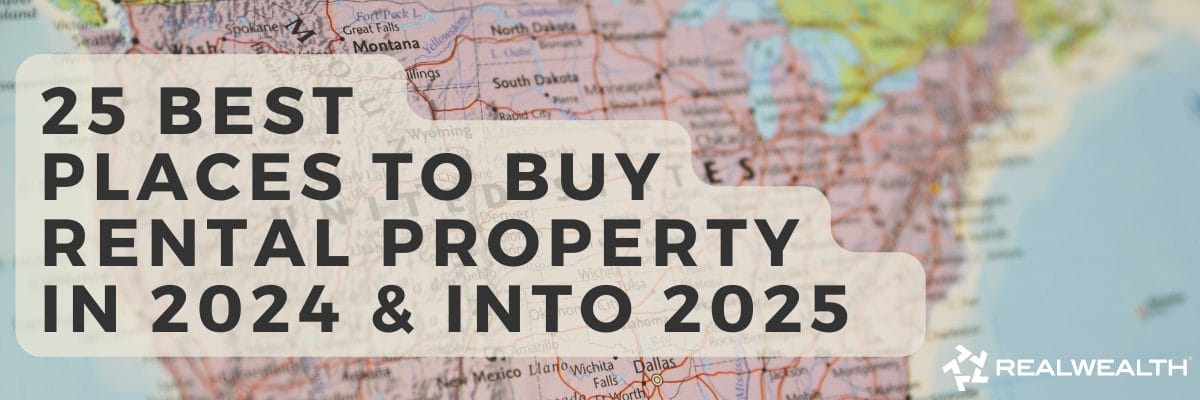Summary: In this article, you will learn the top real estate definitions every investor needs to know. You’ll learn examples, formulas and tips to help explain real estate investing terminology, abbreviations and why they are important for investors to know.
Introduction
Whether you are new to real estate investing or a seasoned expert, this article can help you understand basic to advanced real estate investing definitions. We will cover the most commonly researched real estate investment terms and their respective definitions. Our intent, is for you to use this real estate investing glossary as a quick, easy-to-understand resource for questions, explanations, examples, formulas and investor tips.
Adjustable Rate Mortgage (ARM)

Definition
Adjustable Rate Mortgage (ARM) is a mortgage that does not have a fixed interest rate. An ARM can change monthly, based on benchmark interest rates. It’s typical for an ARM to have a fixed rate the first few years of the loan and then changes periodically.
Why It Matters
This is an important real estate investment definition to understand because mortgage payment amounts could fluctuate over the life of the loan due to market conditions. This fluctuation makes it difficult for investors to estimate their budget and potential return on investment.
long term investing
Amortization

Definition
Amortization is an accounting technique used to lower the cost value of a finite life or intangible asset incrementally through scheduled charges to income.
Why It Matters
Basically, amortization is how a mortgage is paid down over time. An amortized mortgage isn’t paid evenly over the life of the loan. Instead, each month a little more of your money goes toward the loan principal and less towards interest. Each mortgage payment goes toward a portion of the principal and a portion of the interest.
Annual Depreciation Allowance

Definition
Annual Depreciation Allowance is the depreciation of an asset and how much an investor is allowed to deduct or write off every year according to tax code. This is basically the process of deducting costs related to buying and improving an asset or rental property. Instead of one large deduction during the year the property is bought or improved, depreciation deduction is distributed over the “useful life” of a property.
Rental property that qualifies for depreciation allowance must meet the following requirements according to the IRS:
- You own the property. (You are considered the owner even if the property is subject to a debt.)
- You use the property in your business or as an income-producing activity.
- The property has a determinable useful life, meaning that it is something that wears out, decays, gets used up, becomes obsolete or loses its value from natural causes.
- The property is expected to last more than one year.
Investor Tip
Residential property “useful life” term is 27.5 years, while nonresidential property is 39 years. Depreciation deductions are spread over these lengths of time.
Annual Percentage Rate (APR)

Definition
Annual Percentage Rate (APR) is the annual rate charged for borrowing or earned through an investment. APR is expressed as a percentage that represents the actual yearly cost of funds over the term of a loan. This includes any fees or additional costs associated with the transaction but does not take compounding into account
Example of Calculating APR
Most APR’s are calculated as follows: U.S. Prime Rate + The margin the bank charges = APR
Appraised Value

Definition
Appraised value is the evaluation of a property’s value.
Example of Appraised Value / Why It Matters
A professional appraiser is typically hired by the lender during the mortgage origination process and paid for by the borrower. The appraised value determines how much money may be borrowed and under what terms. Loan-to-Value (LTV) is determined by an appraisal.
Appreciation
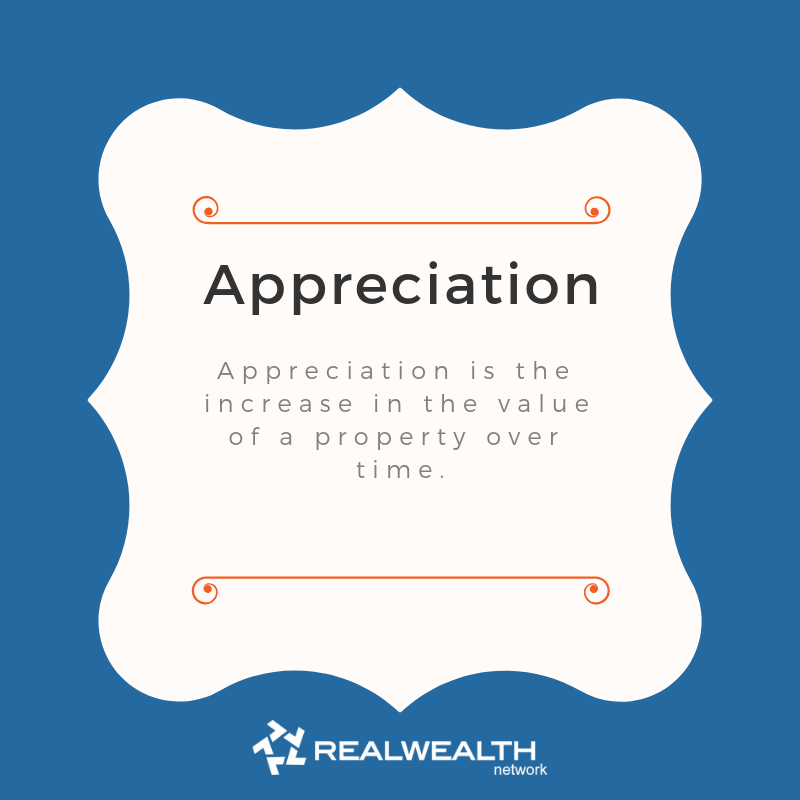
Definition
Appreciation is the increase in the value of a property over time.
Examples of Appreciation
This happens for a few reasons, a rise in demand or a dip in supply, inflation or interest rate fluctuations. Appreciation also builds equity for the owner. Appreciation one of the top real estate definitions for investors to know.
Building Classifications (A,B,C,D)

Definition
Building classifications allow an investor to differentiate buildings and rationalize market data. Investment properties and their value falls into four category classifications, A, B, C or D.
Example of Building Classifications / Investor Tips
An “A” property is more expensive and in higher demand. “A” properties are generally newer, in great condition and in high-demand markets. Older, lower quality construction and in less-desirable areas are classified as B, C or D properties. New investors should consider “B” or “C” properties to balance risk versus reward. “A” properties may have more potential for higher monthly cash flow and return on investment, but the risk is often higher.
Capital Expenditures (CapEx)

Definition
Capital Expenditures (CapEx) are any new purchases or major improvements made that increases the lifespan and value of a property. This also includes any equipment or supplies costs needed to make the improvements.
Examples of CapEx / Why It Matters
New roof, new furnace, new floors, renovating a bathroom, etc. This does not apply to smaller maintenance expenses like, painting, a leaky pipe or carpet cleaning. Capital Expenditures and routine maintenance are taxed differently, so it’s important for investors to understand the difference and list them appropriately on tax forms.
Capitalization Rate (CAP Rate)

Definition
Capitalization Rate is calculated by the Net Operating Income or NOI (defined below) divided by sale price or value of a property.
Investor Tip
This metric helps buyers determine their expected return on investment, prior to factoring in mortgage financing. A low Cap Rate usually comes with lower risk.
Capital Gains Tax

Definition
Capital gains tax is the profit an individual earns from the sale of a property or an investment.
Examples of Capital Gains Tax & Resources
There are two categories for capital gains, short term and long term. Investments that qualify as short term are usually held for a year or less and are taxed at your regular income tax rate. Long term investments are typically held for longer than a year and are taxed at a lower rate than ordinary income tax.
For a more detailed breakdown of capital gains, how they are taxed, and related real estate investment definitions, refer to one of my previous articles, “How Is Passive Income Taxed?”
Cash Flow

Definition
Cash flow is the amount of money that goes into the property owners pocket each month after operating expenses have been paid (including loan payments).
Examples of Cash Flow
Positive cash flow is spending less money than you earn on an income property. Negative cash flow is spending more money than you earn.
Cash on Cash Return (CoC)

Definition
A cash on cash return is the ratio between an assets annual cash flow and the property’s down payment. This is generally calculated before taxes.
Calculating a Cash on Cash Return
CoC is normally used to determine the performance of commercial real estate. To calculate, first determine your annual pre-tax cash flow: (gross scheduled rent + other income) – (vacancy + operating expenses + annual mortgage annual mortgage payments). Then, divide pre-tax cash flow by total cash invested = CoC.
Clear Title

Definition
A clear title is where there is no lien from creditors or others that put into question the legal ownership of an asset. An owner of a home or rental with a clear title can claim full legal ownership of the property, with no disputes from other parties.
Examples of a “Dirty” Title / Investor Tips
Unresolved building code violations can cause a title to be “dirty” and warn investors of potential problems acquiring the property. When looking to purchase investment property, a title search should always be done to ensure clear ownership and avoid any question of who owns the property.
Closing Costs

Definition
Closing costs are paid by the buyer upon purchase of a property, in addition to the down payment. These costs include, mortgage insurance premium, homeowners insurance, points, property taxes, etc.
Investor Tip
Closing costs are usually between 3 percent to 4 percent of the loan amount and another commonly used real estate definition investors should know.
Comparative Market Analysis (CMA)

Definition
A comparative market analysis (CMA) in real estate is a way to compare similar properties within the same area to determine its market value.
Why It Matters
A CMA will help investors understand the current housing market, how much properties similar to yours are worth, and if it’s an investment property, how much you can charge for rent. Real estate agents generally perform a CMA for their clients to determine listing price when selling a home or a price to offer when buying a home. Learn how to do a comparative market analysis in 7 steps.
Contingency

Definition
A contingency is a condition set on the purchase agreement of a property, often with a buyer termination option.
Examples of a Contingency
- A potential buyer making an offer on a home, contingent on the sale of his or her current home.
- An inspection contingency allows the buyer to have the home inspected and negotiate new costs based on the inspection results.
Conventional Mortgage

Definition
A Conventional mortgage is a type of mortgage loan not insured by the Federal Housing Administration (FHA), usually requiring between a 10 percent to 20 percent down payment.
Investor Tip
Conventional loan borrowers who put down at least 20% don’t have to pay for mortgage insurance.
Debt-to-Equity Ratio (D/E)

Definition
Debt-to-Equity Ratio in real estate, is a measure of ownership. How much of the property an investor owns versus how much is owed on the mortgage.
Investor Tips / Why It Matters
This is an important metric because it helps investors have an idea of how much capital they’ve put into the property and how much they could walk away with upon sale. This ratio is also considered when refinancing or borrowing against with a home equity line of credit, to purchase another home or investment property. D/E affects creditworthiness.
Depreciation

Definition
Depreciation is the decrease in the value of a property over time.
Investor Tip
This is where Annual Depreciation Rate comes into play and determines how much a property owner is allowed to deduct every year.
Due Diligence

Definition
Due Diligence is taking caution, performing calculations, reviewing documents, procuring insurance, walking the property, etc., before purchase.
Investor Tips
Ordering an inspection and appraisal of a property is standard due diligence procedure. Basically, doing your homework before buying real estate in order to minimize risk and potential expenses after purchase. It’s best practice for the buyer to personally walk through the property, review all documents, and calculate expenses.
Earnest Money

Definition
Earnest money is a set amount of money submitted by a potential buyer with a purchase offer to show “good faith” that the buyer intends to follow through with the sale of a home.
Investor Tips
The broker holds the money in an escrow account until closing. Earnest money can then be used toward closing costs or down payment upon closing. Earnest money ranges anywhere between $500 and $2,000. The buyer has the potential of losing their earnest money if the sale falls through for reasons caused by the buyer.
Effective Gross Income (EGI)

Definition
Effective Gross Income is the Potential Gross Rental Income plus other income minus vacancy and credit costs of a rental property.
Why It Matters
EGI is meaningful in terms of understanding real estate definitions because it provides the value of a rental and how much positive monthly cash flow it could produce.
Equity

Definition
Equity is the difference between the property’s current market value and the money owed on the mortgage.
Why It Matters
Upon selling the property, equity is the money you would receive after paying off the mortgage amount. Equity can increase as the loan is paid down and/or the value of the property appreciates.
Escrow

Definition
Escrow is when funds, like earnest money, documents, or the property itself, are held by a third party, other than the buyer or seller, and released upon closing.
Example of Escrow
When a property is in “Escrow” it basically means that a purchase offer has been submitted by a potential buyer and a sale is in process.
Fair Housing Act

Definition
The Fair Housing Act is a law that prohibits discrimination from real estate agents, landlords, sellers, or any other person or organization that may have an influence in the decision-making process in the buying, selling, renting or financing of housing.
Why It Matters
The Fair Housing Act prohibits discrimination against people based on race, color, sexual orientation, nationality, religion, disability and family.
FHA Financing
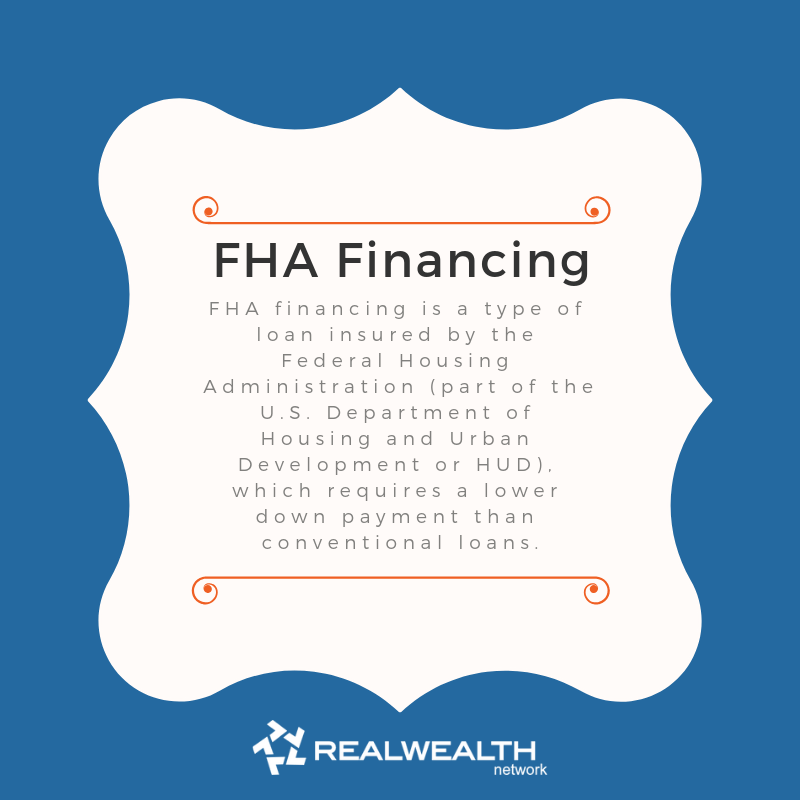
Definition
FHA financing is a type of loan insured by the Federal Housing Administration (part of the U.S. Department of Housing and Urban Development or HUD), which requires a lower down payment than conventional loans.
Investor Tips
Down payment required is usually between 3 percent and 5 percent of home value.
Fixed-Rate Mortgage

Definition
Fixed-Rate mortgage is a type of mortgage that has a set or fixed rate which stays the same throughout the term of a loan.
Investor Tip
This is one of the important real estate investment definitions for investors to know because the same mortgage payment is expected every month and can help accurately predict returns on investment.
Flipping

Definition
Flipping is when investors buy a property, fix it up, and try to sell it for a profit.
Investor Tip
There are many costs associated with flipping that are important to calculate before buying a flip. These include:
- The cost of borrowed money to purchase and/or renovate the property
- The cost to sell: agent fees and closing costs can add up to 10%
- Holding costs – on-going property taxes, interest charges, and insurance
- Unexpected costs – leave a 10% cushion at a minimum.
- Potential dip in sales price – 10% at a minimum.
- Estimated profit – 10% at a minimum (and if this is all you’re expecting, there are much lower risk investments out there!)Short-term capital gains taxes if you sell within a year’s time frame (approximately 35% of your profit). Always talk to your CPA before making any investment!
So, you’ll need to calculate all repair expenses and still be at less than 60% of market value. Is it possible? Yes. Is it easy? No.
Gross Operating Income (GOI)

Definition
Gross Operating Income is the actual amount of rental income an investor receives to service or operate the property, minus vacancy and credit loss.
Calculating GOI
Gross scheduled income – vacancy and credit loss + other income = GOI. An example of “other income” could be income generated from coin-operated laundry.
Gross Rental Yield

Definition
Gross Rental Yield is the total income made from a property, divided by the purchase price and closing costs. “Gross” refers to the total income before deducting operating expenses.
Calculating Gross Rental Yield / Why It Matters
Monthly rent x 12 / purchase price + associated costs = Gross Yield. This gives investors a reference for annualized return on investment.
Gross Scheduled Income (GSI)

Definition
Gross Scheduled Income is annual rental income an investment property could potentially produce if 100% of units were rented.
Calculating GSI
Actual rental income + total potential rent (rental price of vacant units) = GSI.
Homeowner’s Association (HOA) Fees

Definition
A homeowner’s association or HOA creates and enforces rules for properties located in a subdivision, community or condominium. Buying a property within an HOA means that you automatically become a member and must pay monthly HOA fees for maintaining and improving properties within the association.
Why It Matters
If you considering a rental property investment, make sure you know if there will be HOA fees or not. This matters because these fees cut into your cash flow and may impact rental rates.
Income Producing Assets

Definition
Income-producing assets are investments that offer ongoing passive income to the owner.
Examples of Income-Producing Assets
Examples of potential income-producing assets include: rental properties, bonds, dividend stocks, treasuries, systemized businesses that run themselves, and intellectual property that you have licensed.
Inspection Report
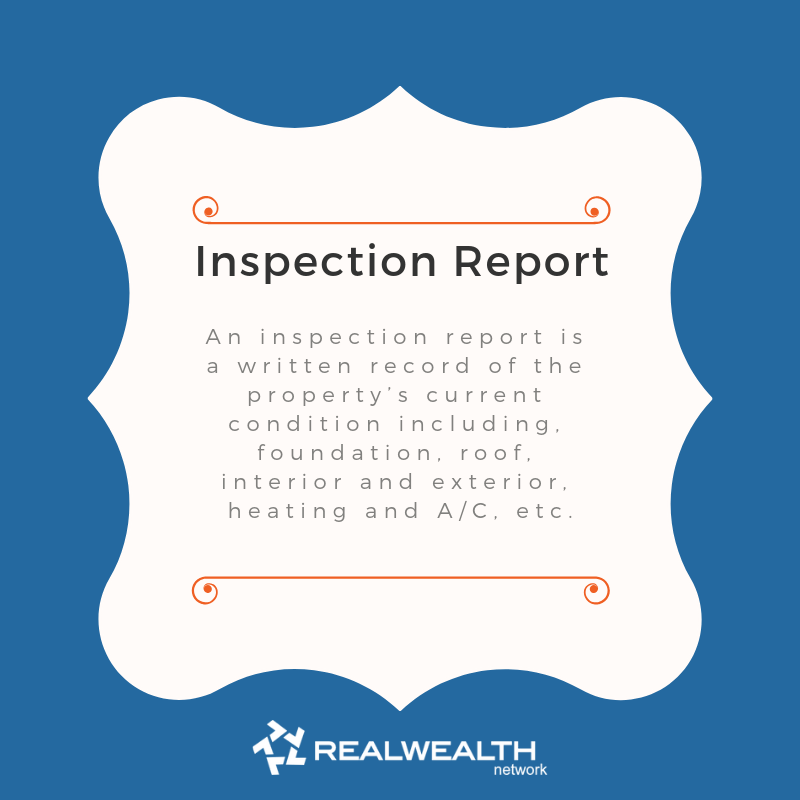
Definition
An inspection report is a written record of the property’s current condition including, foundation, roof, interior and exterior, heating and A/C, etc.
Why It Matters
Inspections are an important step in a buyers due diligence on a property, as it could potentially change the value and selling price of the home.
Internal Rate of Return (IRR)

Definition
Internal Rate of Return is a measurement of a property’s long-term profitability potential. IRR considers the annual net cash flow and change in equity over time.
Why It Matters
Your IRR is the best indicator of a property’s estimated performance over the lifetime of your investment. The higher an IRR, the better the investment.
Leverage

Definition
Leverage is a general term for any technique to multiply gains and potential losses.
Why It Matters
Most often leverage involves buying an asset using borrowed funds, with the belief that the income from the asset will be more than the cost of borrowing.
Loan Origination Fee

Definition
A loan origination fee is charged by the lender for evaluating, preparing and submitting a proposed mortgage loan.
Investor Tips
Origination fees are quoted as a percentage of the total loan, generally between 0.5% and 1% on mortgage loans.
Loan to Value (LTV)

Definition
Loan to Value is how much a lender will loan a borrower based on a percentage of the property’s value.
Investor Tip
The value of a property is usually determined by an appraiser.
Mortgage

Definition
A mortgage is the money borrowed from a lender to purchase real estate.
Investor Tips
It is possible to secure a loan that covers the entire cost of a home; however, it’s more common to obtain a loan for around 80% of the home’s value.
Mortgage Insurance Premium (MIP)

Definition
Mortgage Insurance Premium is an insurance policy used in FHA loans if your down payment is less than 20 percent. The FHA assesses either an “upfront” MIP at the time of closing or an annual MIP that is calculated every year and paid in 12 installments.
Investor Tips
In order to get rid of PMI, you must have at least 20% equity in the home. Once you have paid down the mortgage balance to at least 80% of the home’s original appraised value, ask your lender to cancel PMI. Your lender is required to remove PMI when the mortgage balance drops to 78%.
Multi-Family Homes

Definition
Multi-family homes are a real estate property with more than one unit.
Examples of Multi-Family Homes or Rentals
Apartment buildings, condos, duplexes, and triplexes.
Net Operating Income (NOI)
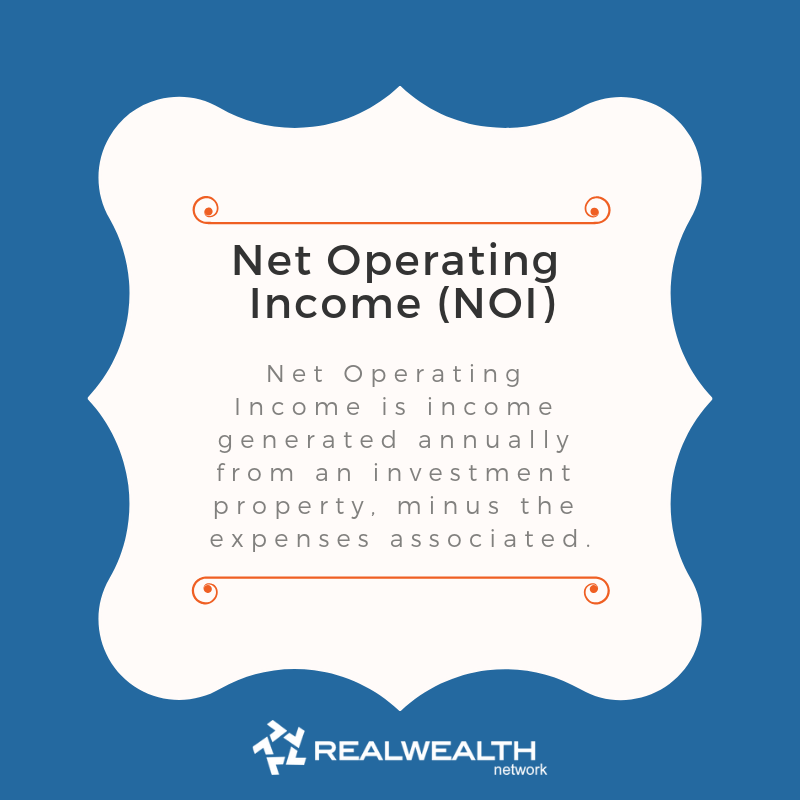
Definition
Net Operating Income is income generated annually from an investment property, minus the expenses associated. NOI is calculated before tax and does not include, depreciation, loan payments, or capital expenses.
Examples of NOI
Expenses include, property management fees, running and maintaining the property, utilities, and property tax.
Points

Definition
Points are fees you pay to your lender upfront when you borrow a loan.
Example of Points
Also known as discount points, this strategy is called “buying down the rate,” which can lower monthly mortgage payments. For example: one point costs 1 percent of your mortgage amount or $1,000 for every $100,000.
Principal

Definition
The principal is the amount of money owed on a loan or mortgage, not including interest.
Investor Tips / Calculating Principal
Principal + Interest + Escrow (homeowners insurance and tax) + Mortgage Insurance (if applicable) = total monthly mortgage payment.
Or: Total monthly mortgage payment – Interest – Escrow – Mortgage Insurance = Principal
Property Taxes

Definition
Property taxes are taxes based on the value of the home that are paid monthly by the homeowner, as part of a mortgage payment.
Why It Matters
Property taxes are used to fund community services like, schools, parks, etc.
Purchase Agreement

Definition
A purchase agreement is a legal contract in real estate between the buyer and seller where all terms and conditions are outlined and agreed upon prior to closing.
Investor Tips
A purchase agreement for a house should include: the exact address of the property, a clear legal description of the property at stake, and the identities of both the seller(s) and buyer(s).
Real Estate Investment Trust (REIT)

Definition
A Real Estate Investment Trust is lot like mutual funds, except they hold individual properties in a trust, rather than stocks and bonds. An REIT buys and manages the real estate properties using investor money.
Investor Tip
REIT’s have many advantages for real estate investors looking to diversify their portfolios and don’t have to manage any properties themselves.
Real Estate Owned (REO)

Definition
Real Estate Owned is when a property is foreclosed on by a bank that held the mortgage, it’s now owned by the bank and is referred to as REO property.
Example of a REO Property
A short sale property is listed as REO and owned by a bank.
Return on Investment (ROI)

Definition
Return on Investment is an accounting term that indicates the percentage of invested money that’s recouped after the deduction of associated costs.
Calculating ROI
There are several variable costs associated with owning a rental property such as, maintenance costs, repairs, renovations, and how much money was borrowed. ROI is one of the top real estate definitions for investors to know.
Determining ROI on cash transactions is pretty straightforward. Calculating ROI on financed transactions is a bit more complicated.
For example, you buy a rental property for $100,000 and put 20% of the purchase price down or $20,000. Closing costs were $2,000 and you spent $5,000 for remodeling. Total out-of-pocket expenses were $27,000 ($20,000 + $2,000 + $5,000).
Next, we need to calculate the costs with a mortgage. Let’s say your loan is 30-years at a fixed 4% interest rate. $80,000 (loan amount) + 4% interest = $381.93 per month on mortgage payment. Add extra costs of $150 for expenses like taxes, insurance, utilities, making your total monthly payment $531.93. Monthly rental income of $1,000, totaling $12,000 per year. Your monthly cash flow or ROI would be $468.07 (or $5,616.84 per year).
Self-Directed Individual Retirement Arrangement (SDIRA) Investing

Definition
SDIRA Investing is using your IRA or retirement account to invest in real estate. Any returns generated from the investment property are tax-deferred and must be deposited back into the IRA. These funds cannot be withdrawn prior to retirement.
Investor Tips
The SDIRA contribution limits for 2018-2019 are as follows:
- $5,500 per year for individuals below 50 years of age
- $6,500 per year for individuals over 50 years of age
Short Sale

Definition
A short sale is when a home or rental property is being sold for less than the amount owed on the mortgage.
Example of a Short Sale
A home is being sold for $150,000 and $175,000 is still owed on the mortgage, the seller is responsible for the $25,000 deficiency.
Single Family Rentals (SFR’s)

Definition
Single Family Rentals are free-standing homes that are used as an investment property to generate passive income.
Investor Tips About SFR’s
SFR’s are often easier to rent out to long-term tenants, especially family’s; they’re easier to easier to finance with long-term fixed loan rates; and they tend to be easier to sell (if they are in the median range of an area with strong population and job growth).
Title Insurance

Definition
Title Insurance is a type of insurance that protects both lenders and homeowners in the event of loss from legal defects of the property title.
Investor Tips
On average, the cost of title insurance is a one-time premium of about $1,000. However, premiums can vary from as little as a few hundred dollars up to $2,000 or more.
Turn-Key Property (TKP)

Definition
A Turn Key Property is a type of investment property that is move-in or almost move-in ready.
Investor Tip
As far as real estate definitions go, Turn Key Properties are appealing to investors because they can be rented out right away, without any major repairs or renovations needed.
Vacancy Rate

Definition
Vacancy rate is the percentage of all units of a rental property that are vacant or unoccupied at any given time.
Calculating Vacancy Rate
Vacancy rates are calculated by the number of vacant units x 100 / total number of units.
Wholesaling

Definition
Wholesaling in real estate is the process through which an individual, the ‘wholesaler,’ acquires a contract from the seller of the property and assigns that same contract to an end buyer. Wholesale properties are discounted, distressed properties usually found through means other than real estate agents or listings.
Why It Matters
Wholesaling is considered among the top short-term investment strategies and a great way for beginner investors to break into the real estate industry. That’s because wholesaling requires very little or no capital to get started.
1% Rule

Definition
The 1% Rule is the rent to expense ratio a property must have in order to produce positive cash flow.
Investor Tips
Rent on an investment property must be at least 1% of the purchase price to get a positive ROI. The 1% rule is more of a rule of thumb as opposed to a hard-and-fast rule.
2% Rule

Definition
The 2% rule suggests that a rental property is a good investment if the money from rent each month is equal to or greater than 2% of the purchase price.
Investor Tips
Much like the 1% rule, the 2% rule is another rent to expense ratio that rental property owners can use to determine if the investment will be cash flowing or not. The 2% rule is another rule of thumb as opposed to a hard-and-fast rule.
1031 Exchange
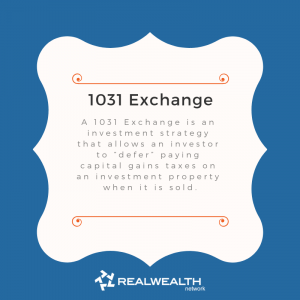
Definition
A 1031 Exchange is an investment strategy that allows investors to “defer” paying capital gains taxes on an investment property when it is sold. As long as another “like-kind property” is purchased with the profit gained by the sale of the first property, according to the IRS.
Investor Tip
There are several rules and guidelines to qualify and complete a 1031 Exchange, so it’s highly suggested to utilize a real estate investment expert or an attorney specializing in real estate.
Conclusion
All the real estate definitions and terms can feel like learning a new language. Learning and understanding the most commonly used real estate investment definitions to ensure that you’re equipped to decide if a rental property will be a good investment or not. Stick to the numbers, avoid letting emotion get in the way and utilize the resources and knowledge gained to make savvy real estate investment decisions.
Sources
- https://www.homeunion.com
- https://www.biggerpockets.com
- https://learn.roofstock.com
- https://www.biggerpockets.com
- https://www.investopedia.com
- https://www.reonomy.com
- http://www.proapod.com
- Fettke, Kathy. Retire Rich with Rentals. 2014.
